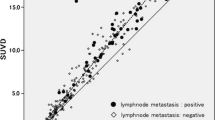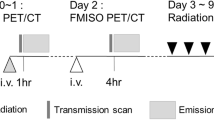Abstract
Objectives
To analyze the diagnostic performance of dual time point imaging (DTPI) for pre-therapeutic lymph node (LN) staging in non-small cell lung cancer (NSCLC).
Methods
This was a retrospective analysis of 47 patients with NSCLC who had undergone DTPI by PET (early + delayed) using F18-fluorodeoxyglucose (FDG). PET raw data were reconstructed iteratively (point spread function + time-of-flight). LN uptake in PET was assessed visually (four-step score) and semi-quantitatively (SUVmax, SUVmean, ratios LN/primary, LN/liver, and LN/mediastinal blood pool). DTPI analyses included retention indices (RIs), Δ-ratios and changes in visual score. Histology or cytology served as standards of reference. Accuracy was determined based on ROC analyses.
Results
Thirty-six of 155 LNs were malignant. DTPI accuracy was low for all measures (visual assessment, 24.5%; RI SUVmax, 68.4%; RI SUVmean, 65.8%; Δ-ratios, 63.9-76.1%) and significantly inferior to early PET. Accuracies of early (range, 86.5–92.9%) and delayed PET (range, 85.2–92.9%) were comparable. At early PET, accuracy of the visual score (92.9%) was similar or superior to semi-quantitative analyses (range, 86.5–92.3%).
Conclusions
Using a modern PET/CT device and novel image reconstruction, neither additional delayed PET nor DTPI analyses improved the accuracy of PET-based LN staging. Dedicated visual assessment criteria performed very well.
Key Points
• DTPI did not improve accuracy of PET-based LN staging in NSCLC.
• Analyzed SUV ratios were not superior to LN SUVmax or SUVmean.
• A four-step visual score may allow highly accurate, standardized LN assessment.




Similar content being viewed by others
References
De Leyn P, Dooms C, Kuzdzal J et al (2014) Preoperative mediastinal lymph node staging for non-small cell lung cancer: 2014 update of the 2007 ESTS guidelines. Transl Lung Cancer Res 3:225–233
Shen G, Hu S, Deng H, Jia Z (2015) Diagnostic value of dual time-point 18 F-FDG PET/CT versus single time-point imaging for detection of mediastinal nodal metastasis in non-small cell lung cancer patients: a meta-analysis. Acta Radiol 56:681–687
Schmidt-Hansen M, Baldwin DR, Hasler E, Zamora J, Abraira V, Rogué I, Figuls M (2014) PET-CT for assessing mediastinal lymph node involvement in patients with suspected resectable non-small cell lung cancer. Cochrane Database Syst Rev. doi:10.1002/14651858.CD009519.pub2
Wu Y, Li P, Zhang H et al (2013) Diagnostic value of fluorine 18 fluorodeoxyglucose positron emission tomography/computed tomography for the detection of metastases in non-small-cell lung cancer patients. Int J Cancer 132:E37–E47
Gonluoglu MZ, Melek H, Medetoglu B, Demir A, Kara HV, Dincer SI (2011) The validity of preoperative lymph node staging guidelines of European Society of Thoracic Surgeons in non-small-cell lung cancer patients. Eur J Cardiothorac Surg 40:287–290
Lasnon C, Hicks RJ, Beauregard JM et al (2012) Impact of point spread function reconstruction on thoracic lymph node staging with 18F-FDG PET/CT in non-small cell lung cancer. Clin Nucl Med 37:971–976
Bryant AS, Cerfolio RJ, Klemm KM, Ojha B (2006) Maximum standard uptake value of mediastinal lymph nodes on integrated FDG-PET-CT predicts pathology in patients with non-small cell lung cancer. Ann Thorac Surg 82:417–422
Uesaka D, Demura Y, Ishizaki T et al (2008) Evaluation of dual-time-point 18F-FDG PET for staging in patients with lung cancer. J Nucl Med 49:1606–1612
Shinya T, Rai K, Okumura Y et al (2009) Dual-time-point F-18 FDG PET/CT for evaluation of intrathoracic lymph nodes in patients with non-small cell lung cancer. Clin Nucl Med 34:216–221
Boellaard R, O'Doherty MJ, Weber WA et al (2010) FDG PET and PET/CT: EANM procedure guidelines for tumour PET imaging: version 1.0. Eur J Nucl Med Mol Imaging 37:181–200
Mountain CF, Dresler CM (1997) Regional lymph node classification for lung cancer staging. Chest 111:1718–1723
DeLong ER, DeLong DM, Clarke-Pearson DL (1988) Comparing the areas under two or more correlated receiver operating characteristic curves: a nonparametric approach. Biometrics 44:837–845
Langen KJ, Braun U, Rota Kops E et al (1993) The influence of plasma glucose levels on fluorine-18-fluorodeoxyglucose uptake in bronchial carcinomas. J Nucl Med 34:355–359
Zasadny KR, Wahl RL (1993) Standardized uptake values of normal tissues at PET with 2-[fluorine-18]-fluoro-2-deoxy-D-glucose: variations with body weight and a method for correction. Radiology 189:847–850
Boellaard R, Krak NC, Hoekstra OS, Lammertsma AA (2004) Effects of noise, image resolution, and ROI definition on the accuracy of standard uptake values: a simulation study. J Nucl Med 45:1519–1527
Jaskowiak CJ, Bianco JA, Perlman SB, Fine JP (2005) Influence of reconstruction iterations on 18F-FDG PET/CT standardized uptake values. J Nucl Med 46:424–428
Akamatsu G, Mitsumoto K, Taniguchi T, Tsutsui Y, Baba S, Sasaki M (2014) Influences of point-spread function and time-of-flight reconstructions on standardized uptake value of lymph node metastases in FDG-PET. Eur J Radiol 83:226–230
Suga K, Kawakami Y, Hiyama A et al (2009) Differential diagnosis between (18)F-FDG-avid metastatic lymph nodes in non-small cell lung cancer and benign nodes on dual-time point PET/CT scan. Ann Nucl Med 23:523–531
Kim DW, Kim WH, Kim CG (2012) Dual-time-point FDG PET/CT: Is It Useful for Lymph Node Staging in Patients with Non-Small-Cell Lung Cancer? Nucl Med Mol Imaging 46:196–200
Nguyen P, Bhatt M, Bashirzadeh F et al (2015) Comparison of objective criteria and expert visual interpretation to classify benign and malignant hilar and mediastinal nodes on 18F FDG PET/CT. Respirology 20:129–137
Shim SS, Lee KS, Kim BT et al (2005) Non-small cell lung cancer: prospective comparison of integrated FDG PET/CT and CT alone for preoperative staging. Radiology 236:1011–1019
Yeh DW, Lee KS, Han J et al (2009) Mediastinal nodes in patients with non-small cell lung cancer: MRI findings with PET/CT and pathologic correlation. AJR Am J Roentgenol 193:813–821
Wang J, Welch K, Wang L, Kong FM (2012) Negative predictive value of positron emission tomography and computed tomography for stage T1-2N0 non-small-cell lung cancer: a meta-analysis. Clin Lung Cancer 13:81–89
Shim SS, Han J (2010) FDG-PET/CT imaging in assessing mucin-producing non-small cell lung cancer with pathologic correlation. Ann Nucl Med 24:357–362
Sobin LH, Gospodarowicz MK, Wittekind C (2009) TNM Classification of Malignant Tumours, 7th edn. Wiley-Blackwell, Hoboken, NJ
Acknowledgments
The scientific guarantor of this publication is Prof. Holger Amthauer. The authors of this manuscript declare no relationships with any companies whose products or services may be related to the subject matter of the article. The authors state that this work has not received any funding. One of the authors has significant statistical expertise. Institutional review board approval was obtained (study ID number, RAD271; vote, 44/15). Written informed consent was obtained from all patients in this study. Methodology: retrospective, diagnostic study performed at one institution.
Author information
Authors and Affiliations
Corresponding author
Rights and permissions
About this article
Cite this article
Rogasch, J.M.M., Steffen, I.G., Riedel, S. et al. Dual time point imaging for F18-FDG-PET/CT does not improve the accuracy of nodal staging in non-small cell lung cancer patients. Eur Radiol 26, 2808–2818 (2016). https://doi.org/10.1007/s00330-015-4093-5
Received:
Revised:
Accepted:
Published:
Issue Date:
DOI: https://doi.org/10.1007/s00330-015-4093-5




